Search this site ...
Contemporary African
Textile Art
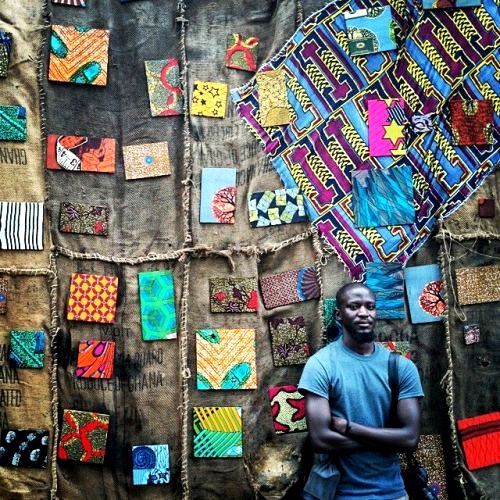
Contemporary African Textile Art continues to gather and grow in increasingly exciting and dynamic ways.
With the use of textiles and/or found materials, contemporary African artists are re-inventing the historic and the traditional in both surprising and innovative ways.
Most processes require a direct and sustained engagement with the materials and the form of making becomes an intrinsic part of the art and the meaning. A perfect example is the work of artist Ibrahim Mahama's shown in the image above. He uses hessian sacks bearing traces of coal and cocoa production from his home country of Ghana to further exaggerate and highlight various issues facing both his home country and the continent at large. These statement pieces brings to the fore Africa's role in the exchange of commodities and the migration of people.
Contemporary Textile Artists
From the series 'Studies of African Art from Picasso's Collection' VII - appliqué, embroidery, patchwork and Dutch Wax fabric
The following are just some of the artists making waves in this area. Some have a longer history than others but each consistently makes a valuable and significant contribution to this dynamic and expressive form of art-making (primarily 2-dimensional).
- Hassan Musa b 1951, Sudan
- Abdoulaye Konate b 1953, Ghana
- Yinka Shonibare b 1962, UK
- Victor Ehikhamenor b 1970, Nigeria
- Billy Zangewa b 1973, Malawi
- Lizette Chirrime b 1973, Mozambique
- Turiya Magadlela, South Africa b 1978, Johannesburg, SA
- Grace Ndiritu b 1982, Kenya/UK
- Anthony Bumhira, b 1985 Zimbabwe
- Marcellina Akpojotor Oseghale b 1989, Lagos, Nigeria
- Siwa Mgoboza b 1993, Cape Town, SA
- Angela Franklin Faye, Senegal/USA
- Kyle Meyer b 1985, USA
- Tschabalala Self, b 1990, USA
- Kwesi Kwarteng, b Ghana
Billy Zangewa
Born in Malawi and raised in Botswana, Billy Zangewa attended college in Grahamstown, South Africa and currently resides and works out of Johannesburg.
Originally trained in printing and graphic design, she won the Absa L'atelier Gerard Sekoto Award in 2004 with a triptych of handbags. After becoming totally enamored by silk squares given to her by a friend she began producing the unique, gloriously colored and textured Dupion silk collages that we know today as her signature art.
Her intricate, hand-stitched and carefully appliqued self-portraits challenge the objectification and stereotyping of the black female body. The soft silky materials belie the potency of her message.
Planning and preparation is essential to her process... the drawing stage is critical, underpinning the cutting and placement of layers of fabric. Large blank areas are contrasted and offset by detail and texture building up the imagery and the narrative.
Each work is deceptively simple and can take up to 3 months to complete.The irregularity of the shape is a feature of her works, leading the viewer to the fact it is not a painting.
Abdoulaye Konate
Born in 1953 in Dire, Mali Abdoulaye Konate continues to live and work in Bamako despite international acclaim for his work. He is deeply committed to his own culture and his textile sculptures offer a limitless source of artistic and spiritual expression for this artist.
Konate employs bazin, a traditional Malian fabric which he dyes with pigments and cuts into strips. Playing with volume, depth and colour, he layers and superimposes these strips into large-scale abstract or figurative compositions.
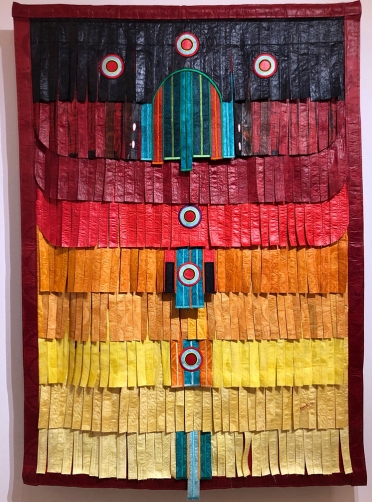 Abdoulaye Konate 'Marrakech'
Abdoulaye Konate 'Marrakech'In his work he delivers his own interpretations of world events but also makes reference to his own cultural history using these cloths to list signs and symbols (amulets) of secret Malian societies. His colors can have symbolic overtones or aesthetic ones... sometimes playful, sometimes with highly sophisticated gradations of tone and texture.
'Clothes of Heaven' is a series of textiles he developed to exhibit in Morocco in 2017. Incorporating motifs, symbols and colours that reflect the dialogue he explored between the artisans of Fez and traditional Moroccan textiles, the beautiful and resonant results speak for themselves.
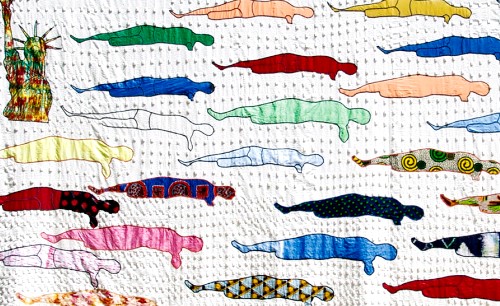 'Generation Biometrique', 2008, applique - Abdoulaye Konate
'Generation Biometrique', 2008, applique - Abdoulaye KonateWhile Konate's initial artistic discipline was painting he became passionate about using fabric as his medium of choice after being awarded the Leopold Sedar Senghor Prize at the Dak'Art Biennale in 1996.
His early pieces were often figurative like the cloth above and are appliqued using a variety of coloured and patterned fabrics in relief against a white background. The title of the series Generation Biometrique (completed in 2013) refers to the generalised government methods of processing immigrants and focuses on the plight and conditions of African migrants entering the EU and America.
Victor Ehikhamenor
Born in Edo State, Nigeria Victor Ehikhamenor now lives in Lagos. His village and ancestral home Uwesan forms the primary source of his inspiration and he draws influence from the traditional motifs and religious cosmology of his heritage.
He spent time studying in Maryland, USA and returned to his home country in 2008. It was then he realised that what he had passively observed all his life like patterns on the walls, carved sculptures in the shrines, paintings and murals were all in fact art.
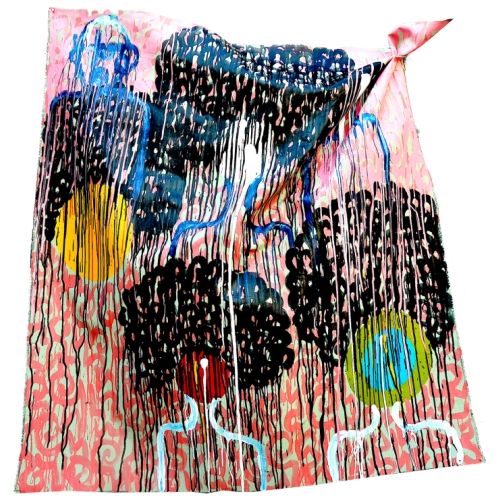 Victor Ehikhamenor 'Girls of Aba'
Victor Ehikhamenor 'Girls of Aba'His work is abstract, symbolic and politically motivated such as the piece above which refers to the stolen girls of Aba. He uses mixed media, paint, textiles, photographs, canvas print, thread, rosary beads, rosaries.. anything that is pertinent to his message.
Names, texts, symbols are employed in his art and assist in revealing the historical culture of a tribe and the welfare and aspirations of its people. Memory, royalty and nostalgia are central themes in his work.
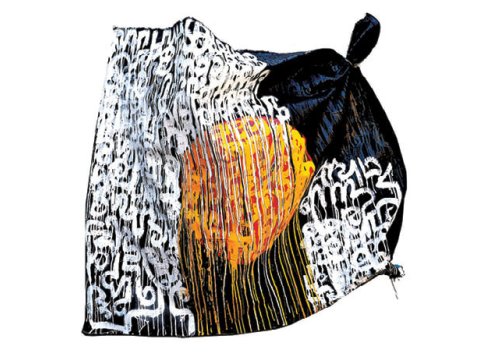 'The Sun In Father’s Belly', 2016. Mixed media on canvas
'The Sun In Father’s Belly', 2016. Mixed media on canvasHis work is often heavily titled helping the viewer to understand the situation, the character and the intention behind the piece. The piece below is from a series entitled 'In the Kingdom of the World' which seeks to place the Benin kingdom in juxtaposition with the English Empire.
His work has graphic qualities that have been used in many book covers and periodicals. It is also collected by private and public institutions literally throughout the world.
Angela Franklin Faye
Born in the USA, Angela Franklin Faye divides her time between the United Arab Emirates, Senegal and the States. As well as being an acclaimed artist she is also the founder and director of a multicultural bookstore and academic resource centre called Chez Alpha Books situated in Dakar.
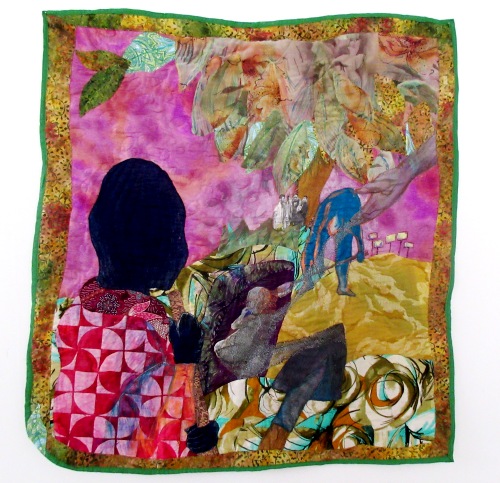 Angela Franklin Faye, Dak'Art 2017
Angela Franklin Faye, Dak'Art 2017Her works are narrative tales that give testimony to people of the African Diaspora, their shared experiences and philosophies related to other cultures. Says Franklin-Faye, "Fabric is often perceived as a delicate medium yet the messages I choose to delver are often quite powerful."
Its through her artwork she can best express an opinion and respond to global and social issues.
Siwa Mgoboza
Born in 1993 in Cape Town, SA, this contemporary African artist spent time abroad in Peru and Poland before returning to the place of his birth to study at Michaelis School of Art in 2012. Majoring in painting, he turned to textiles in his final year and predominantly using Shweshwe fabrics began to form the collages that have become synonymous with his name.
Shweshwe is a fabric that has many connotations and a complicated history in South Africa... a printed cotton designed by settlers, produced in bulk in Indonesia and assimilated into African culture, highly desired in Afro-Chic movements. Mgoboza re-invents it in a concept he terms Africadia, a place where identity is no longer defined by race, class, gender or religion.
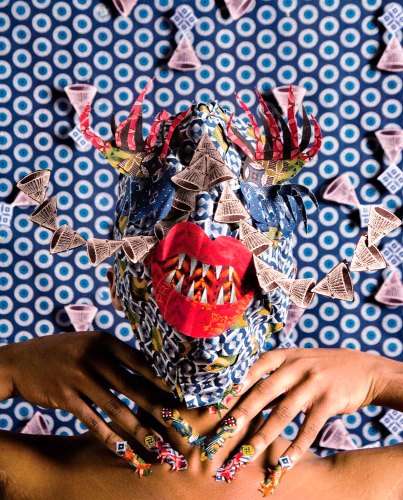 Siwa Mgoboza 'Mask'
Siwa Mgoboza 'Mask'Blurring the lines between tapestry, beading, sculpture and photography the collages are composed in the same way as a painting with perspective, focus, light, depth and scale being carefully considered. Each piece can take up to a couple of months to finish and Mgoboza employs a team of 3 ladies to assist him in the cutting, making and beading.
The idea of camouflage and assimilation is instrumental in his art, trying to fit in, to blend and be accepted; trying to 'belong' is paramount to the personal crisis defined in his work.
His 3-dimensional pieces are realised with the use of fabric cut outs creating depth and theatrical drama. An installation piece like the one above includes materials like cotton tulle, mirrors, cotton thread, plywood and pinewood.
Siwa asks the rhetorical question "What kind of a person would emerge when there are no longer any boundaries?"
Tschabalala Self, USA
Born in Harlem, New York in 1990, this artist has quickly established herself in the contemporary art world. For Tschabalala Self, the combination of the courageous exploration of her themes and the dynamic and unusual use of her medium seem to have hit a nerve demanding a favorable response from public and collectors alike.
A painting titled "Out of Body' sold for an astounding hammer price of $382 000, five times its estimate in Christie's 2019 Summer Post-War and Contemporary Art Sale.
Part of this connection that she makes is that in this day of social media and stardom, Self portrays her subjects as ordinary people doing ordinary things. But the underlying message is that everybody's story is infinitely complex and worthy of representation.
Self uses textiles to to give everyday things material form. Concerned with identity and the figure, she finds patchwork and collage ideal for showing how the body is comprised of multiple elements - an individual is made up of a whole lot of different aspects.
Her dimensional paintings or collages use a full range of materials and pigments: acrylic, watercolor, gouache and coloured pencils, bits of found, inherited or purchased cut-up fabrics and finally, embellishments like thread, sequins and glitter to sew on to the canvas creating a rich visual delight.
"Irreverant and tenderly poignant" is how one critic describes her work
Read further here: 'Community and Culture', Interview with Anne Ellegood
Kwesi Karteng
Born in Ghana and currently living in the US, this contemporary African textile artist emigrated from Ghana to the States as a teenager. His heritage is tightly bound up in his works; using a diversity of fabrics including Dutch wax he explores ideas of multiculturalism, identity and global connectivity.
In Ghana the colors and fabrics of clothing worn by individuals conveys different milestones and/or emotional states. He encodes his work with multicultural symbols that are easily recognized within specific cultures but creatively appreciated by all.
Kwarteng has a painting background and he approaches his canvases the same way as a painting. The canvases are dyed using different processes, then combined with cloth and sewing to create one of his dramatic and unique pieces. Championing the cause for immigration and world integration, his contemporary textiles are collected widely.
Textile Artists Using Photography
Photography provides another medium in which to both celebrate the heritage and explore the future of textiles, woven cloth and printed/embroidered/stitched/dyed fabrics from Africa.
The 2 artists featured below are just a small representation of the many who are finding personal expression and creativity through film and photographic imagery.
Zohra Opuku
Zohra Opuku hails from Accra and works as a multi-media artist practicing installation, sculpture and photography.
Born in 1976 in Germany her work makes references to her heritage like Kente cloth from her Ghanain father but it can also just reveal her interest in the cultural significance of garments that stretches beyond her family.
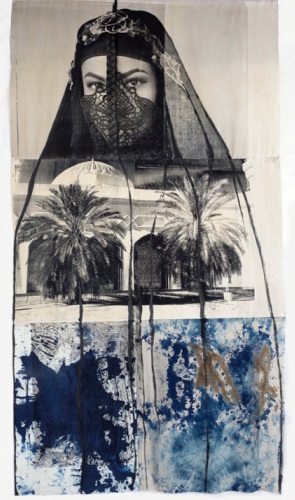 Zohra Opoku 'Within Us'
Zohra Opoku 'Within Us'She manages to powerfully mesh photography and fabric to investigate connections between codes of dress and culture. Nowhere is this more apparent than in her Harmattan Tales series devoted to her interpretations of the Muslim veil and the ladies behind them.
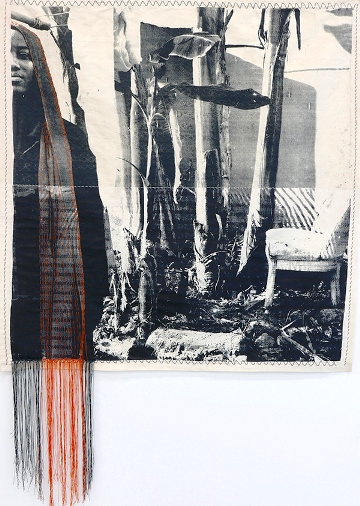 'Raddiya', 2017-2018, Screenprint on cotton, thread
'Raddiya', 2017-2018, Screenprint on cotton, threadShe screen prints her photographs on to fabric bought at the local market, (often bedsheets), then embellishes them with beads, vibrant colored thread or swatches of lace making them much more sculptural and complex in application. Some images are overprinted or restitched, some have sweeping brushstrokes or physical adornments.. they definitely take on an alluring element.
She says "I always look at identity via textile culture and symbolism, because I come from a handcraft family in Germany and I studied fashion design," she says. "I enjoy working with something that's flexible, that's alive, that tells stories by its history of use.
"Textiles are fundamental to my work. It just satisfies me a lot to handle a piece of cloth and to discover it from different perspectives, like textures, the history and age and how I can bring out the beauty of meaning within a body of work".
Marion Boehm
Born in 1964 in Germany, Marion Boehm moved to South Africa in 2010 where her artistic career was launched with her unique photographic collages. Focusing on social, economic and cultural matters on the African continent she has produced a number of series, developing themes with titles such as Tribal Sands, Cotton Fields, Missionary, Stitched, Human Zoo, Ancestors and Black Paris to name some of the prolific work she has created.
Starting with historical photographs, predominantly black and white and topical to the series being worked on, her first pieces used discarded newspapers and sweshwe fabrics.
After that her collages on paper became more and more intricate with stitchery, embroidery, lace, velvet, beads, appliqued fabric flowers and leaves, antique textiles, woven braid.... basically whatever it takes to recreate her portraits.
Disconcertingly, Boehm's portraits always take the same stance, a front view looking directly at the observer and forcing a confrontation, a silent reproach in their eye.
Textile Installation Artists
These artists listed below work in major textile creations that are sculptural/3D in form... whether they are just mounted on the wall in relief or included in a full room-installation piece.
- El Anatsui, b 1944, Ghana
- Sanaa Gateja b Uganda
- Yinka Shonibare b 1962, UK
- Olanrewaju Tejuoso b 1974, Nigeria
- Nnenna Okore b 1975, Australia/Nigeria
- Nicholas Hlobo b 1975, South Africa
- Georgina Maxim b 1980 Zimbabwe
- Victoria Udondian b 1982, Nigeria
- Serge Clottey, b 1985, Ghana
- Ibrahim Mahama, b 1987, Ghana
- Troy Makaza b 1994, Zimbabwe
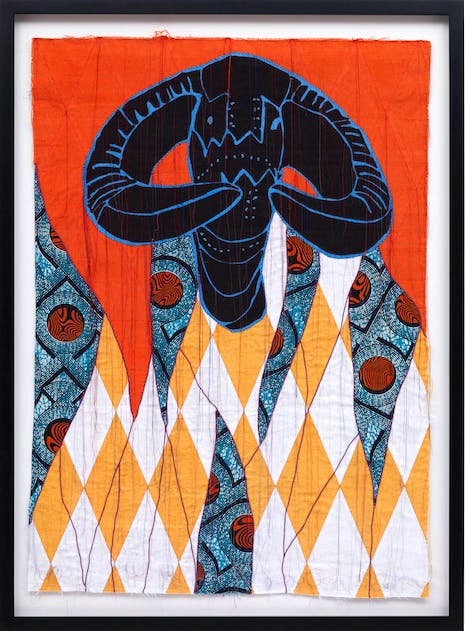
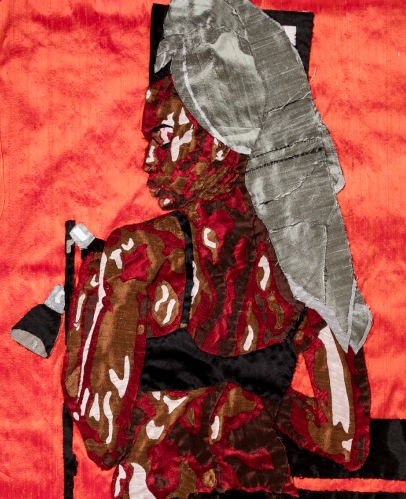
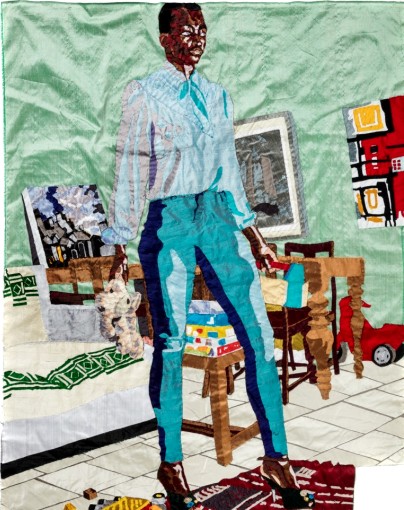
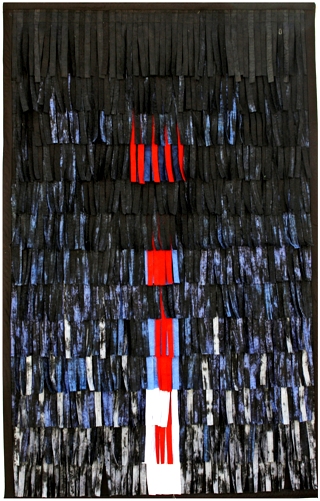
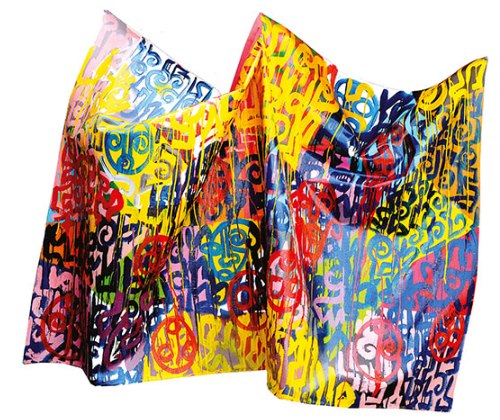
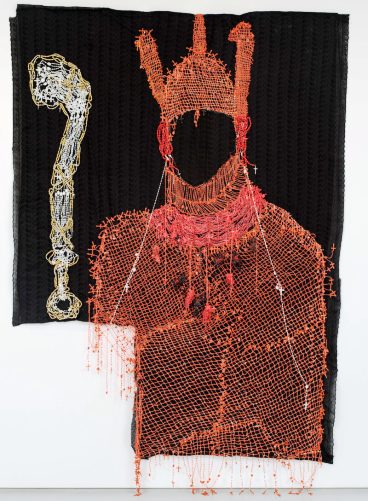
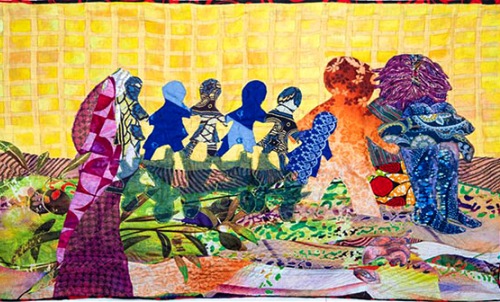
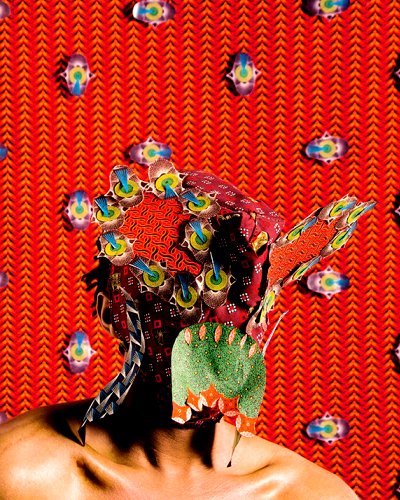
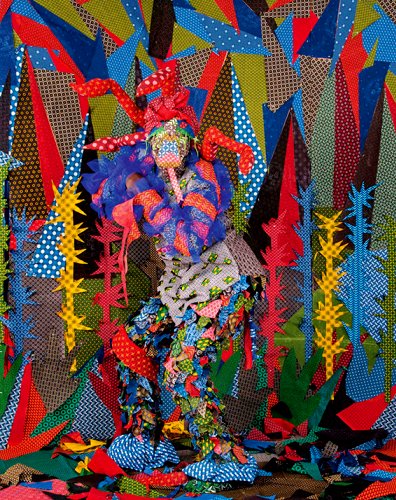
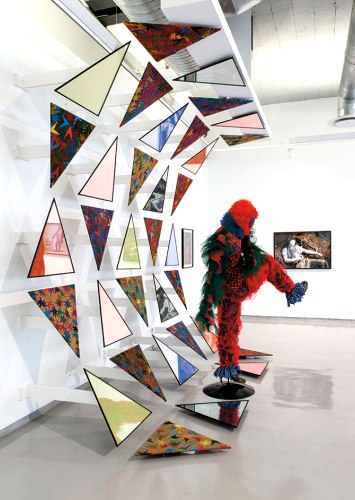
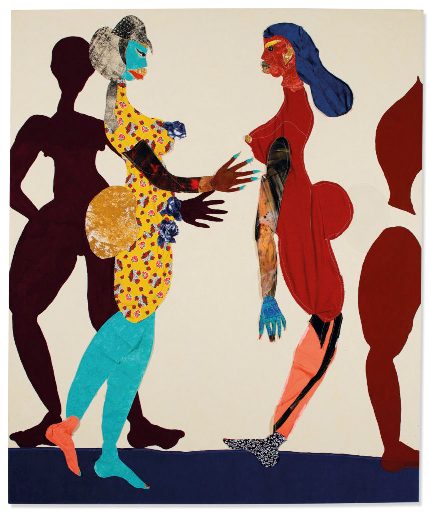
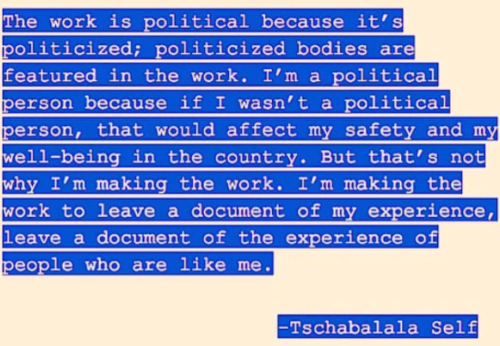
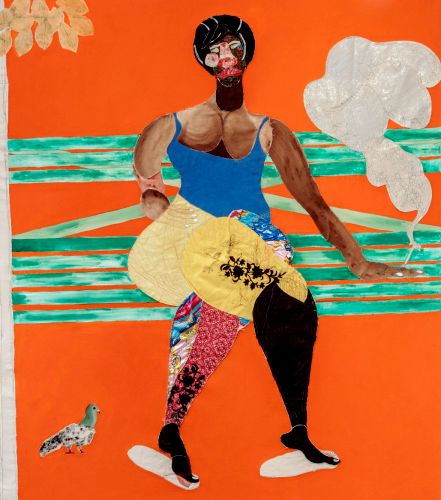
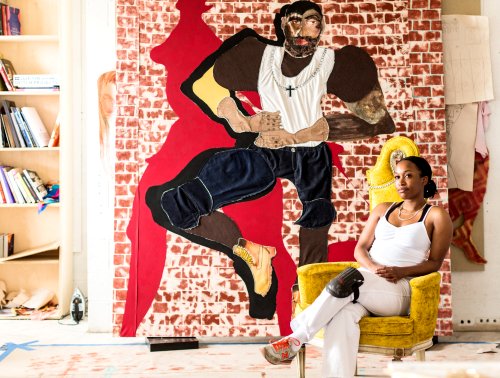
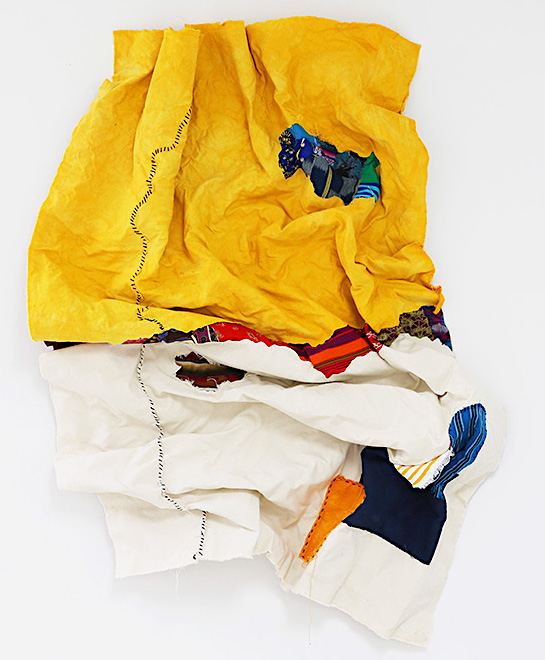
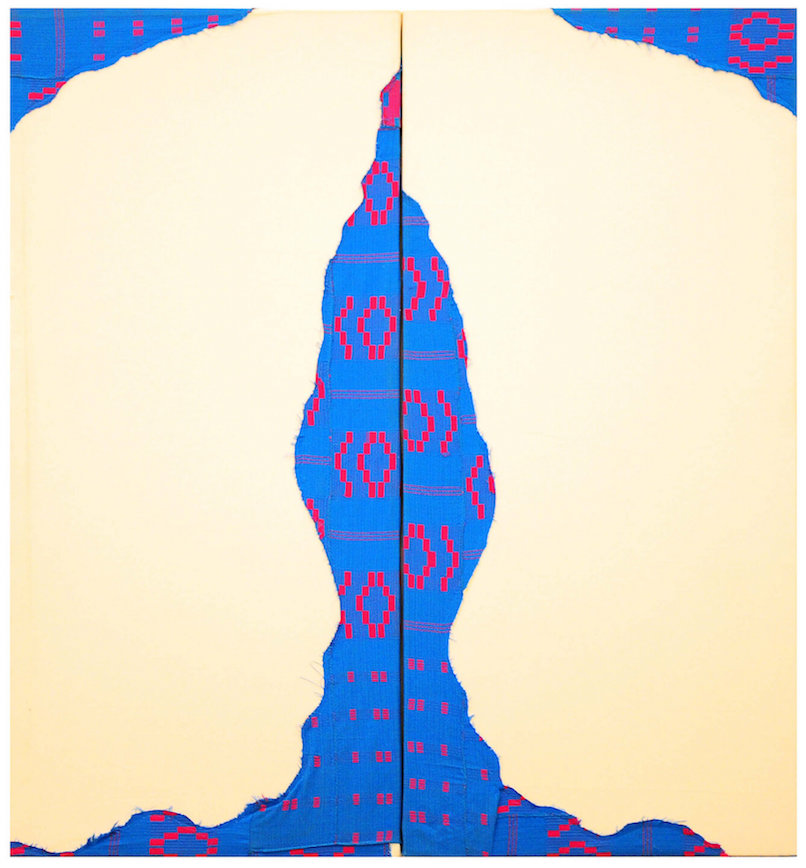
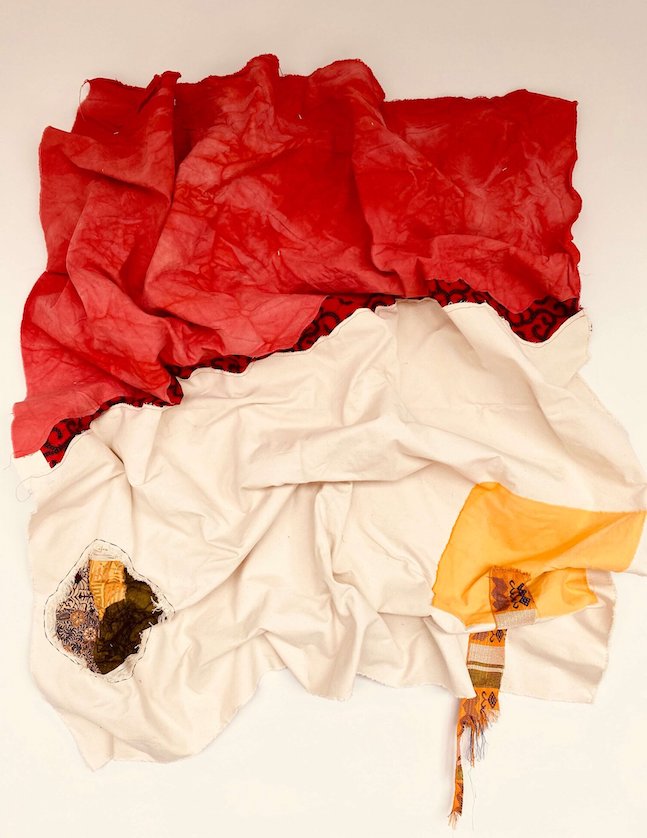
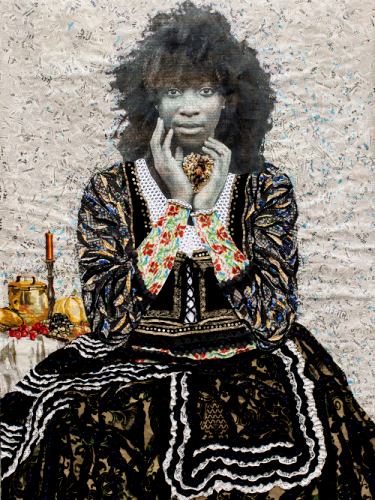
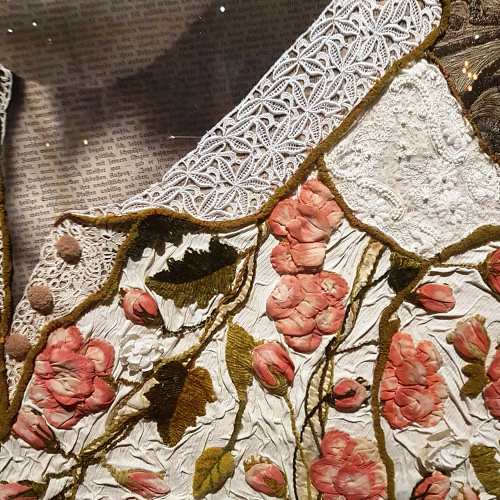
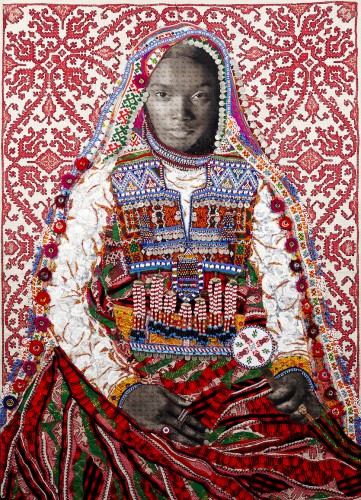
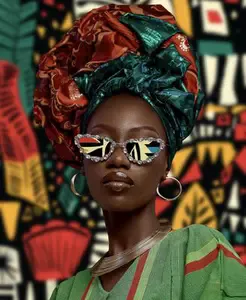
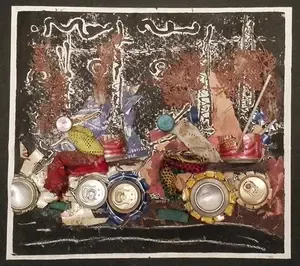
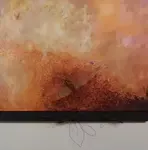
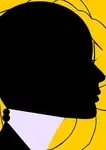
New! Comments
Have your say about what you just read! Leave me a comment in the box below.